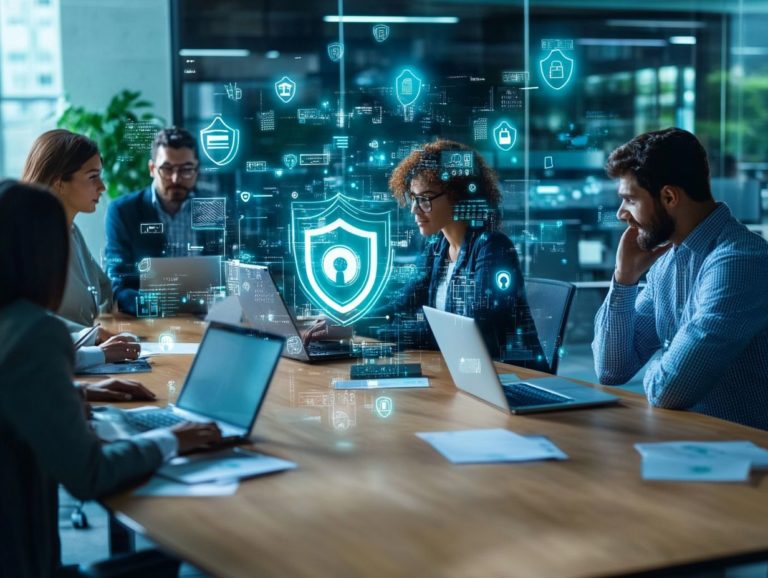best practices for implementing managed security services
In the ever-evolving digital landscape, your organization encounters a growing spectrum of security threats that require more than just traditional defenses. Managed security services (MSS) present a proactive solution, offering you expert oversight and advanced protection tailored to your needs.
This discussion delves into the myriad benefits of implementing MSS, ranging from enhanced security to significant cost savings. It will guide you through essential considerations prior to adoption. Uncover best practices for seamless implementation, effective metrics for measuring success, and strategies for continuous improvement. This ensures your organization remains resilient against the relentless tide of online threats.
Contents
- Key Takeaways:
- Benefits of Implementing Managed Security Services
- Factors to Consider Before Implementing Managed Security Services
- Assessing Your Organization’s Needs and Goals
- Best Practices for Implementing Managed Security Services
- Measuring Success and Making Adjustments
- Preguntas Frecuentes
- Cu les son las mejores pr cticas para implementar servicios de seguridad administrados?
- Por qu es importante definir los requisitos de seguridad antes de implementar servicios de seguridad administrados?
- C mo puedo elegir un proveedor confiable para servicios de seguridad administrados?
- Qu deber a incluir un plan de seguridad integral?
- Por qu es importante la capacitaci n de los empleados en los servicios de seguridad administrados?
- Con qu frecuencia deben monitorearse y probarse los sistemas y procedimientos de seguridad?
Key Takeaways:

Improved security and cost savings are two major benefits of implementing managed security services for businesses. Assessing your organization’s needs and goals is crucial before implementing these services to ensure a successful integration. Additionally, understanding how to stay compliant with managed security services is essential. Developing a comprehensive plan, choosing the right provider, and ensuring smooth integration are key best practices for implementing managed security services.
What are Managed Security Services?
Managed security services (MSS) are specialized solutions that you can leverage to navigate the complex landscape of online threats in today’s IT environment. However, it’s important to be aware of common pitfalls in managed security services to ensure you maximize their effectiveness. These services encompass a variety of critical practices, including:
- Security Information and Event Management (SIEM), a system that collects and analyzes security data
- Vulnerability assessment
- Incident response
- Data encryption
- Adherence to compliance requirements like GDPR and HIPAA
This ensures a comprehensive approach to cybersecurity. With online threats becoming more frequent and sophisticated, you must protect your sensitive data and maintain your operational integrity.
Key components, such as SIEM, play a pivotal role by aggregating and analyzing security data from across your organization in real time. This enables you to proactively detect anomalies.
Vulnerability assessments are equally important. They help you identify potential weaknesses in your systems and applications before they can be exploited.
Effective incident response strategies give you a structured approach to manage and mitigate security breaches. This ensures rapid recovery and minimal damage.
By integrating these services, you not only strengthen your defenses but also comply with rigorous standards, ultimately enhancing your overall security posture.
Benefits of Implementing Managed Security Services
Implementing managed security services presents a wealth of advantages that enable your organization to align security practices seamlessly with your business needs and strategic goals. For insights on how to transition to managed security services, this approach ensures cost-effective protection against the ever-evolving landscape of online threats, allowing you to focus on what truly matters: driving your business forward.
Improved Security and Cost Savings
One of the standout benefits of managed security services is the substantial enhancement in your security posture. This is coupled with the cost savings realized through more efficient use of security controls and cybersecurity tools.
By tapping into advanced cybersecurity technologies, these services enable you to detect potential threats in real time. This results in quicker response times and more effective remediation strategies.
This proactive stance helps you reduce risks and minimize downtime. Downtime can otherwise take a significant toll on your finances.
Outsourcing your security needs allows you to allocate resources more effectively. This frees up capital that would typically be consumed by maintaining an in-house security team.
Ultimately, this approach not only strengthens your defense mechanisms but also improves your financial performance by cutting down on the costs associated with data breaches and compliance penalties.
Factors to Consider Before Implementing Managed Security Services
Before you implement managed security services, it’s essential to meticulously assess your business needs. Additionally, consider how to optimize your managed security service experience by evaluating the reputation of potential security providers to ensure you make the best choice.
Ensuring compliance checks will significantly enhance your cybersecurity posture. Are you ready to take your security to the next level? Contact us today to learn how managed security services can safeguard your business!
Assessing Your Organization’s Needs and Goals

Assessing your organization’s needs and goals is vital when considering Managed Security Services. This alignment ensures your Cyber Threat Management practices match your strategic objectives.
Begin by evaluating your current security protocols. Identify specific vulnerabilities that pose risks. Analyze your existing infrastructure, employee behavior, and data handling practices to uncover areas of concern.
By recognizing potential threats like cyber attacks and data breaches, you can make informed decisions about which managed security services to implement. This assessment shapes your security strategy and ensures it aligns with your organizational objectives, fostering a proactive stance against potential issues.
A strategic approach cultivates a well-rounded security posture tailored to your organization s unique needs.
Best Practices for Implementing Managed Security Services
Effectively implementing Managed Security Services requires adherence to best practices. Start with crafting a detailed plan and establishing a strong security framework to guide the process, focusing on the key features of effective managed security services.
Developing a Detailed Plan
A good plan for Managed Security Services should include key components like a Security Operations strategy and an Incident Response Plan. To enhance your approach, it’s important to understand how to evaluate managed security services effectively, ensuring effective layered security against threats.
This approach is essential for organizations looking to build a strong defense. By outlining protocols for incident detection, analysis, and mitigation, the plan enables swift responses to security breaches.
Incorporating threat intelligence and conducting regular vulnerability assessments strengthens your security posture. Additionally, providing staff training equips your team to handle crises confidently.
Ultimately, a well-structured plan serves as a roadmap, navigating today s complex threat landscape while ensuring compliance with industry regulations.
Choosing the Right Provider
Choosing the right security provider can make or break your cybersecurity efforts! A solid track record and responsive customer support greatly influence your security outcomes.
When evaluating potential providers, delve into their history of delivering strong security options and assess client ratings. Timely customer support is crucial for resolving urgent security issues, ensuring minimal downtime and maintaining operational integrity.
Proactive monitoring tools are vital as they facilitate real-time threat detection and prompt incident response. This blend of expertise and reliability safeguards your organization s sensitive data and strengthens overall security.
Ensuring Smooth Integration
Ensuring smooth integration of managed security services is essential for effectively leveraging cybersecurity tools and measuring the effectiveness of managed security services to enhance your Security Information and Event Management capabilities.
This process highlights adopting advanced technologies, like tools that spot potential cyber threats in real-time, which are critical for bolstering your security posture.
Implementing continuous risk scanning helps identify vulnerabilities quickly, allowing for swift remediation before threats escalate.
Effective communication among all stakeholders is also important. Everyone should be aligned on security protocols and response strategies.
By fostering collaboration between your IT teams and service providers, you can navigate challenges efficiently and achieve a robust cybersecurity framework that adapts to evolving threats.
Measuring Success and Making Adjustments

Measuring success in implementing Managed Security Services involves tracking key metrics that accurately reflect your organization’s security posture and understanding what to expect from managed security services.
This approach allows for continuous improvement, enabling you to enhance your security measures effectively.
Is your organization ready to elevate its security strategy today?
Key Metrics to Track
Tracking key metrics is crucial for evaluating the effectiveness of your Managed Security Services. For guidance on this, learn how to choose the right managed security service provider by focusing on Security Audits, Threat Detection rates, and adherence to Compliance Policies.
By monitoring these metrics, you gain vital insights into potential weak spots and the overall strength of your cybersecurity posture. Stay ahead of threats by tracking these key metrics.
Regularly conducting thorough security checks helps pinpoint gaps and inefficiencies that could expose you to risks.
Threat Detection rates reveal how effectively your managed security system can respond to incidents in real time.
Compliance metrics, especially those aligned with industry standards like GDPR or HIPAA, ensure that you re not just protected but also meeting legal requirements.
In this ever-evolving landscape, leveraging these key metrics enables you to make informed decisions that significantly enhance your security framework.
Continuously Improving Your Security Strategy
Continuously improving your security strategy requires regular assessments and adjustments based on insights gained from continuous risk scanning and effective remediation practices. This proactive approach allows you to identify weak spots before they can be exploited, ensuring your defenses remain robust and up to date.
Implementing regular security audits and assessments helps gather valuable data about potential risks and threats, informing necessary changes to your strategy.
Security awareness training is essential for enabling your employees to recognize suspicious activities and respond appropriately, thereby reinforcing your organization s overall security posture.
Integrating effective remediation methods addresses existing weak spots while fostering a culture of vigilance, enabling you to adapt to new challenges as they emerge.
Preguntas Frecuentes
Cu les son las mejores pr cticas para implementar servicios de seguridad administrados?
1. Defina sus requisitos de seguridad: Antes de implementar cualquier servicio de seguridad administrado, es esencial definir claramente sus necesidades y prioridades de seguridad.
2. Elija un proveedor confiable: Investigue y eval e diferentes proveedores de servicios de seguridad administrados para encontrar uno que satisfaga sus necesidades espec ficas y tenga un historial comprobado en la industria.
3. Desarrolle un plan de seguridad: Trabaje con su proveedor para crear un plan de seguridad integral que se alinee con sus objetivos comerciales e incluya actualizaciones y mantenimiento regulares.
4. Capacite a los empleados: Eduque a sus empleados sobre la importancia de la seguridad y capac telos sobre c mo usar y proteger adecuadamente los datos sensibles.
5. Monitoree y pruebe regularmente: Monitoree y pruebe sus sistemas y procedimientos de seguridad para identificar vulnerabilidades y abordarlas de inmediato.
6. Tenga un plan de recuperaci n ante desastres: En caso de una brecha de seguridad, tener un plan de recuperaci n ante desastres detallado puede ayudar a minimizar el impacto y hacer que su negocio vuelva a funcionar lo m s r pido posible. No espere a que ocurra una brecha: cree un plan de recuperaci n ante desastres ahora para proteger su negocio.
Por qu es importante definir los requisitos de seguridad antes de implementar servicios de seguridad administrados?

Definir sus requisitos de seguridad le permite identificar y priorizar posibles amenazas y vulnerabilidades, lo que ayuda a su proveedor a crear una soluci n a medida que aborde eficazmente sus necesidades espec ficas. Tambi n garantiza que no est pagando por servicios innecesarios, ahorr ndole tiempo y dinero a largo plazo.
C mo puedo elegir un proveedor confiable para servicios de seguridad administrados?
Investigue y eval e diferentes proveedores en funci n de su experiencia, reputaci n en la industria y los servicios espec ficos que ofrecen. Pida referencias y estudios de caso para obtener una mejor comprensi n de sus capacidades y niveles de satisfacci n del cliente. Adem s, aseg rese de que el proveedor cumpla con las regulaciones relevantes y tenga las certificaciones adecuadas.
Qu deber a incluir un plan de seguridad integral?
Un plan de seguridad integral debe tener una evaluaci n de riesgos, pol ticas de seguridad y un plan de respuesta a incidentes.
Tambi n es clave realizar actualizaciones regulares y ofrecer entrenamiento a los empleados. Es fundamental abordar el cumplimiento de las leyes y asegurar la privacidad de los datos.
Por qu es importante la capacitaci n de los empleados en los servicios de seguridad administrados?
Los empleados son a menudo el eslab n m s d bil en la seguridad de una empresa. Por eso, deben saber c mo proteger adecuadamente los datos sensibles.
Esto puede ayudar a prevenir errores humanos y reducir el riesgo de brechas de seguridad.
Con qu frecuencia deben monitorearse y probarse los sistemas y procedimientos de seguridad?
Es recomendable monitorear y probar los sistemas de seguridad al menos cada tres o seis meses.
Esto es clave para identificar vulnerabilidades y corregir problemas antes de que se conviertan en brechas de seguridad.






